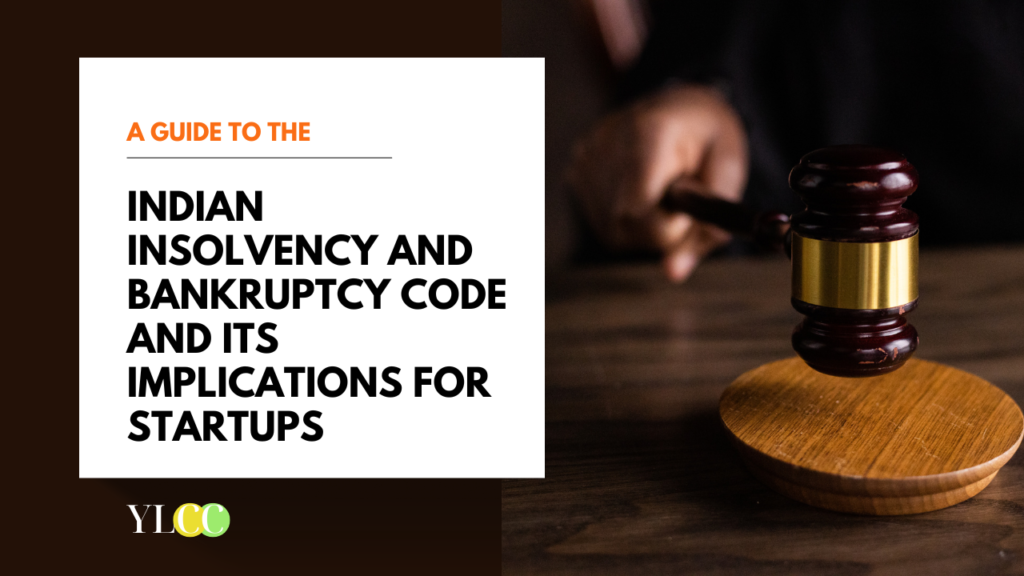
INTRODUCTION
The Insolvency and Bankruptcy Code, 2016 (hereinafter referred to as ‘IBC’ or ‘Code’) is a crucial legislation that has reformed the insolvency and bankruptcy process in India. aims to streamline insolvency cases and ensure the recovery of distressed assets, benefiting various sectors, including the growing startup ecosystem. Its primary objective is to expedite the resolution process, replacing outdated laws with a consolidated framework that promotes transparency, accountability, and fair play. The IBC’s implementation has significant implications for stakeholders and enhances investor confidence in the Indian economy.
Recently, Justice Sanjay Kishan Kaul of the Supreme Court emphasized the significant impact of the IBC on India’s burgeoning startup culture. He highlighted that the IBC has been instrumental in creating a conducive environment for aspiring entrepreneurs in the country (see here). The IBC has significant implications for startups in India. Startups, being innovative and risk-taking ventures, often face financial challenges and the risk of insolvency. The IBC recognizes this and incorporates provisions specifically tailored to address the unique needs and concerns of startups. It provides them with a structured framework for insolvency resolution, offering an opportunity to revive and restructure their businesses, and allows the start-ups to effectively manage their financial distress, seek potential turnaround opportunities, and safeguard the interests of both startups and their creditors. Team YLCC brings a startup guide to the Indian Insolvency and Bankruptcy Code and explores the implications of the Code for startups. Gear up!
OVERVIEW OF IBC
IBC is a comprehensive legislation enacted in 2016 to overhaul the insolvency and bankruptcy framework in India and seeks to expedite the resolution of distressed entities, promote efficient asset recovery, and maintain a healthy business environment. To grasp the essence of the IBC, it is crucial to comprehend its purpose and objectives, as well as its key features and provisions, including the different types of insolvency processes it encompasses.
The Purpose and Objectives:
The primary purpose of the IBC is to establish a single, unified law for insolvency and bankruptcy in India, and the following are the key objectives:
- The Resolution: The IBC aims to ensure the timely resolution of distressed entities by setting strict timelines and reducing delays in the insolvency process.
- The Value: The IBC endeavours to maximize the value of distressed assets by facilitating resolution mechanisms such as restructuring, revival, or liquidation, depending on the circumstances of the case.
- The Treatment: The IBC emphasizes fair and equitable treatment of all stakeholders involved in the insolvency process, including creditors, debtors, and shareholders.
- Entrepreneurship: The IBC aims to foster a culture of entrepreneurship by providing a mechanism for viable businesses to revive and continue their operations, thus contributing to economic growth.

Key Features:
The IBC incorporates several key features and provisions to achieve its objectives, which include, but are not limited to:
- Insolvency Resolution Process: The IBC establishes a time-bound insolvency resolution process, wherein a resolution professional is appointed to manage the affairs of the distressed entity and formulate a resolution plan.
- Insolvency Adjudicating Authorities: The National Company Law Tribunal (NCLT) and the Debt Recovery Tribunal (DRT) are the designated authorities responsible for adjudicating insolvency and bankruptcy cases under the IBC.
- Insolvency Professionals: Section 3(19) of the Code defines an Insolvency Professional (IP). The Code recognizes insolvency professionals who act as intermediaries in the resolution process. They play a crucial role in managing the affairs of the distressed entity and facilitating the resolution process.
Types of Insolvency Processes:
The IBC provides for two primary types of insolvency processes, including:
- Corporate Insolvency Resolution Process (CIRP): Chapter II of the Code for the provisions of CIRP. This process applies to corporate entities, including startups. It involves initiating insolvency proceedings against a defaulting entity and formulating a resolution plan to revive the business or liquidate its assets.
- Individual Insolvency Resolution Process (IIRP): Chapter III of the Code provides for the provisions of IIRP. This process applies to individuals, including sole proprietors and partnerships. It allows insolvent individuals to seek a resolution by formulating a repayment plan or opting for bankruptcy, depending on the circumstances.
INSOLVENCY AND BANKRUPTCY RESOLUTION PROCESS FOR STARTUPS
Startups, being dynamic and innovative ventures, may encounter financial challenges and the risk of insolvency. The Code recognizes the unique circumstances of startups and incorporates specific provisions and considerations to address their needs. Understanding the provisions, eligibility criteria, and steps involved in the insolvency and bankruptcy resolution process for startups is crucial for entrepreneurs and stakeholders.
Specific Provisions and Considerations for Startups:
The Code acknowledges the distinctive nature of startups and provides certain provisions and considerations to facilitate their insolvency resolution. The following are the key provisions:
- Fast-track Process: The Insolvency and Bankruptcy Board of India (IBBI) incorporated the Insolvency and Bankruptcy Board of India (Fast Track Resolution Process for Corporate Persons) Regulations, 2017. These regulations have been enacted by the IBBI under the powers vested in it by Sections 58, 196, and 208, along with Section 240 of the Code. Startups that qualify as small companies [other than the partnership firm(s)], as defined by the Companies Act, 2013, can opt for the fast-track insolvency resolution process. This process aims to expedite the resolution and reduce the time and cost involved.
- Moratorium Period: The Code does not provide a specific definition for the term Moratorium. Upon initiation of the insolvency process, a moratorium period is granted, during which no legal action can be taken against the startup. This allows the startup to focus on the resolution process without external disruptions.
- Resolution Plan Modifications: The IBC allows for the modification of the resolution plan during the implementation stage, providing flexibility to address the unique needs and dynamics of startups.
Eligibility Criteria & the Steps Involved for Startups to Initiate Insolvency Proceedings:
For startups to initiate insolvency proceedings under the IBC, they must meet certain eligibility criteria. These criteria may include the following:
- Definition of Startup: Startups must qualify as per the definition provided by the Department for Promotion of Industry and Internal Trade (DPIIT), which includes factors such as date of incorporation, turnover, and nature of the business.
- The threshold for Default: The startup must have defaulted on its debt payment obligations. The specific threshold for default is determined by the IBC and may vary based on the nature of the debt.
The Insolvency and Bankruptcy Resolution Process for Startups typically involves the following steps:
- Initiation of Proceedings: The Startup or its Creditors can initiate insolvency proceedings by applying with the National Company Law Tribunal (NCLT), the designated authority for insolvency cases. In case the application is filed by the Financial Creditor, Section 7(1) applies, and in case of an Operational Creditor Section 9(1) applies.
- Appointment of Insolvency Professional [Section 125(1)]: Upon admission of the application by the NCLT, an insolvency professional is appointed to manage the affairs of the startup during the resolution process.
- Formation of Creditors’ Committee: A Committee of Creditors is constituted, comprising the financial creditors of the startup. This committee plays a crucial role in approving the resolution plan. The interim resolution professional shall constitute a committee of creditors under Section 21(1) of the Code.
- Formulation and Approval of Resolution Plan [Section 31(1)]: The resolution professional, with the involvement of the creditors’ committee, formulates a resolution plan to revive the startup or liquidate its assets. The plan is presented to the NCLT for approval.
- Implementation of the Resolution Plan [Section 30(2)(d)]: If the resolution plan is approved, it is implemented, and the startup’s affairs are managed according to the plan. The plan may involve restructuring, capital infusion, or any other measures deemed necessary for the revival of the startup.
IMPLICATIONS OF THE CODE FOR STARTUPS
The Code has profound implications for startups, influencing various aspects of their operations and prospects. It brings both advantages and challenges that startups need to navigate. Understanding these implications is crucial for startups operating within the insolvency landscape.
Advantages of the Code for Startups:
- Creditor Protection: The Code emphasizes the protection of creditors’ rights, ensuring a fair distribution of assets during the resolution process. This gives confidence to creditors, encouraging them to lend to startups and support their growth. Additionally, the creditor protection provisions also enhance the overall stability of the startup ecosystem.
- Access to Expertise: The Code provides startups with access to specialized professionals and expertise in the field of insolvency and bankruptcy. This includes Insolvency Professionals, Resolution Professionals, and other experts who can guide startups through the resolution process.
- Structured Revival Mechanism: The Code provides a structured framework for distressed startups to revive their businesses. It offers mechanisms such as resolution plans, debt restructuring, or even liquidation, depending on the circumstances. This structured approach gives startups a clear roadmap for navigating the insolvency process and exploring potential avenues for recovery.
Challenges for Startups:
- Complex Proceedings: The insolvency proceedings under the IBC can be complex, requiring startups to navigate legal and procedural intricacies. It may necessitate the involvement of insolvency professionals, legal advisors, and other experts to ensure compliance and maximize the chances of a favourable resolution.
- Creditors’ Influence: While the IBC aims to strike a balance between the interests of startups and their creditors, the influence of creditors in the resolution process may pose challenges. Startups need to effectively negotiate with creditors and develop resolution plans that address their financial obligations while providing a viable path forward.
Impact on Startup Funding and Investor Confidence:
- Funding Opportunities: The structured resolution process and creditor protection provisions enhance investor confidence in startups facing financial distress. Investors are more likely to consider funding distressed startups when there is a well-defined framework in place for resolution, reducing their perceived risks.
- Investor Confidence: The emphasis on transparency, accountability, and timely resolution enhances investor confidence in the startup ecosystem. The presence of a robust insolvency framework provides reassurance to investors that their rights and interests will be protected, fostering a conducive environment for investment.
- Risk Perception: The Code encourages a culture of risk-taking by providing distressed startups with an avenue for revival. The existence of a structured resolution mechanism instils confidence in entrepreneurs to undertake innovative ventures, knowing that there is a legal framework to address potential financial challenges.
CONCLUSION
The Insolvency and Bankruptcy Code, 2016 has had a profound impact on startups in India. It offers specific provisions and considerations for distressed startups, providing a structured framework for their resolution. The IBC ensures creditor protection, access to expertise, and a clear roadmap for revival. Although startups may face challenges in complex proceedings, the IBC enhances investor confidence and fosters a culture of risk-taking. The IBC has reformed the insolvency landscape, benefiting startups and promoting transparency and accountability in the process.
This article has been written by Team YLCC. For any other queries, reach out to us at: queries.ylcc@gmail.com




